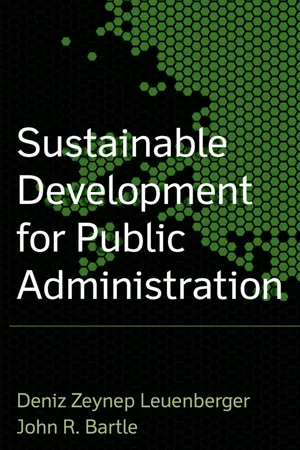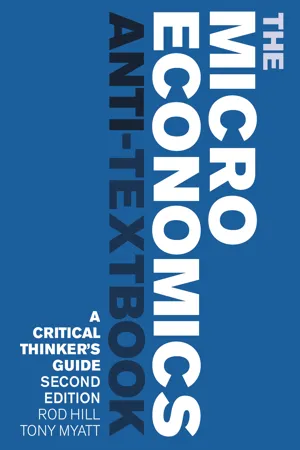Correcting Externalities
Correcting externalities refers to the actions taken to address the impact of external costs or benefits associated with economic activities. This can be achieved through government intervention, such as implementing taxes or subsidies, or through the establishment of property rights and regulations. The goal is to internalize the externalities, ensuring that the true costs and benefits are reflected in decision-making.
8 Key excerpts on "Correcting Externalities"
- eBook - ePub
Environmental and Natural Resource Economics
A Contemporary Approach
- Jonathan M. Harris, Brian Roach(Authors)
- 2021(Publication Date)
- Routledge(Publisher)
...Positive externalities result when economic activities bring benefits to others not directly involved in the transaction. Preservation of open land benefits those who live nearby, often raising their property values. The use of solar energy benefits society as it reduces pollution levels. When a positive externality exists, there is an economic case for a subsidy to increase the market provision of the good. An alternative to the use of a tax is the assignment of property rights to externalities. If there is a clear legal right either to emit a certain amount of pollution or to prevent others from emitting pollution, a market in “rights to pollute” can develop according to the Coase theorem. However, this solution depends on the ability of firms and individuals to trade these pollution rights with relatively low transaction costs. Where large numbers of people are affected, or where the environmental damages are not easy to define in monetary terms, this approach is not effective. It also raises significant questions of equity, because under a market system, the poor generally bear a heavier burden of pollution. Key Terms and Concepts Coase theorem economic efficiency elasticity of demand elasticity of supply environmental justice equilibrium price external costs free market environmentalism free-rider effect holdout effect internalizing externalities marginal benefit marginal cost negative externality optimal pollution Pigovian (pollution) tax polluter pays principle positive externality social marginal cost curve socially efficient subsidy transaction costs upstream tax welfare analysis Discussion Questions “Solving the problems of environmental economics is simple...
- eBook - ePub
- Bonnie Nguyen, Andrew Wait(Authors)
- 2015(Publication Date)
- Routledge(Publisher)
...CHAPTER 17 Externalities DOI: 10.4324/9781315690339-17 17.1 Introduction As we have seen in previous chapters, competitive markets are usually Pareto efficient. This is because all mutually beneficial trades 1 occur, maximizing the gains from trade and hence total surplus. However, there are some situations where the market outcome will not be efficient; these are called market failures. This chapter examines one type of market failure: externalities. An externality is a cost or benefit that accrues to a person who is not directly involved in an economic activity or transaction. The presence of an externality means that the market outcome may not be efficient, because the market does not take into account these external costs and benefits of producing or consuming a product. This means that a competitive market can end up producing too much of a product (with a negative externality) or too little (when there are external benefits). We begin with a discussion of the nature of and the market failure associated with externalities, and then turn to several possible solutions to this market failure. 17.2 External costs and benefits An externality is a cost or benefit of an economic activity that accrues to a person not directly involved in that activity. 2 These costs or benefits are also known as ‘external costs’ or ‘external benefits’. A positive externality occurs when the economic activity results in external benefits for a third party. For example, if a student decides to pursue further education, there may be benefits to society as a whole from having better-educated citizens, in addition to the individual benefits that are enjoyed by the student themselves. A negative externality occurs when the economic activity results in external costs for a third party...
- John R. Bartle, Deniz Zeynup Leuenberger(Authors)
- 2014(Publication Date)
- Routledge(Publisher)
...Missing this opportunity means that society is not using its resources as well as possible. However, it also has another important implication: that some level of pollution is usually better than a zero level. Despite the problems it creates, pollution is the by-product of valued productive activities, such as traveling in cars, food processing, steel manufacturing, and so on. Unless technology makes a zero-pollution process possible, people have to accept some pollution in order to enjoy these productive activities. Therefore, the goal is to balance the negative externality of water pollution against the production of electricity that is essential in modern life. The economic rule in this situation is to internalize the externality; that is, to take the external cost into account in the decision-making of the producer and the consumer of the good. The separation of the external cost from the transaction was the cause of the problem in the first place, so the solution should correct this error. Similarly, with a positive externality, people enjoying the production or consumption decision of another should do something to show the value of the good to them. Maybe I should buy the flower seeds and fertilizer for the flower garden you planted. This will reduce the cost of the garden to you and encourage you to plant more flowers, which we both will enjoy. Addressing Externalities Externalities can be internalized in a variety of ways. One approach is to tax a negative externality and subsidize a positive externality. For example, the government taxes the purchase of tobacco and alcohol because the consumption of these goods hurts not only consumers but others as well. The government subsidizes research and immunization because many people benefit from these goods in addition to the producer and consumer. This approach is known as a Pigouvian approach, named after the French economist A.C. Pigou (1946), who first suggested it...
- eBook - ePub
Environmental and Natural Resources Economics
Theory, Policy, and the Sustainable Society
- Steven Hackett, Sahan T. M. Dissanayake(Authors)
- 2014(Publication Date)
- Routledge(Publisher)
...The term externality refers to the fact that these benefits or costs are not reflected in market demand and supply. Positive externalities are external benefits generated from production and exchange and enjoyed without payment by members of society. An example would be the benefits received by neighbors when homeowners beautify their yards and adjoining roads and sidewalks. As those who benefit from positive externalities do not pay for them, their willingness-to-pay is not included in market demand, and accordingly market demand is too small. In the example given above, the market for landscaping materials and services will produce an inefficiently small quantity because the external benefits enjoyed by the neighbors are not reflected in market demand. Other examples of positive externalities include the external benefits from vaccinations for infectious disease (reduced likelihood of epidemic), the external benefits from literacy and education in a democratic society (more informed voting and civic participation), and the external benefits from land stewardship practiced by farmers, ranchers, and timberland owners (reduced likelihood of flooding, improved groundwater quality, open space, and so forth). In each case the buyers in the market receive private benefits, but there are also external benefits that are not included in the market, which is why an inefficiently small quantity is produced by the market. Negative externalities are external costs generated from production and exchange and borne without compensation by members of society. The prime example is pollution generated as a by-product of producing electricity. Profit-maximizing firms in otherwise well-functioning competitive markets have an incentive to pollute if doing so allows them to reduce their own costs and thus raise their profits...
- eBook - ePub
The Economics of Property and Planning
Future Value
- Graham Squires(Author)
- 2021(Publication Date)
- Routledge(Publisher)
...There is a third external party that will incur a cost, which will not always be met by the consumer or producer – this is where the concept of externalities is introduced. With regard to the subject of this book, applications of market failure and externalities are made to property and planning phenomena. For example, the long-term over supply as a result of low demand for housing in many places can be seen as an inefficient allocation of resources for housing and therefore a sign of market failure in the housing market. Illustrations of externalities are those such as pollution and CO 2 release that are symptomatic of the market failing to internalise payments for all costs in manufacture and service provision of environmental products. Work around externalities does originate in the neoclassical paradigm, in that a market with respect to supply and demand, internalises externalities within the confounds of a market. However, the degree to which externalities can be put under focus can draw new approaches to move outside of the basic market premise of there always being a long-term market equilibrium. Externalities can therefore inspire alternative approaches (covered earlier) such as Behavioural economics, Marxian economics, and Ecological economics. In addition to exploration and analysis using entrepreneurial-profit shifts as associated with the Austrian school, or technological temporal shifts in the Schumpeterian tradition. Revisiting markets, market shaping, and profit margin motivations To get to the point of breaking down the (neo)classical, we need to revisit that a market is, if in some instances in property and planning the market may tend to fail. A market is defined here as the place in which the free transaction of two parties takes place, nominally a buyer and a seller, who will agree to exchange a quantity of goods and services at an agreed price...
- eBook - ePub
- Raghbendra Jha(Author)
- 2009(Publication Date)
- Routledge(Publisher)
...4 External effects and the market mechanism DOI: 10.4324/9780203870044-4 Key concepts: externalities; market failure; the Coase solution; Pigovian taxation and subsidization; conditional perfect price discrimination; conditional perfect internalization; common property resources; multilateral externalities 4.1 Introduction In Part I we have examined the circumstances under which the market mechanism works efficiently. More specifically the second classical theorem of welfare economics, which was proved in Chapter 2, delineates these conditions. If such conditions did indeed obtain there would be no reason for government intervention in the working of the market mechanism. We realize, of course, that the conditions of this theorem are very stringent. In this chapter we relax one of these conditions and examine the implications for public policy. It has been implicit in our analysis so far that the preference ordering of any consumer is defined over her own consumption set. Similarly it has been assumed that the production set of any producer is independent of the production sets of other producers and consumption sets of consumers. In real life these assumptions are often violated and we have interdependence between production and/or consumption sets. When this occurs, an externality is said to exist. Formally, then, an externality is a commodity which is produced during the production and/or consumption of other goods and which affects other producers/consumers. When a paper mill dumps toxic waste into a river, thus contaminating the fish downstream, it affects the production sets of fishermen living downstream. When your neighbor plays loud music late at night when you are trying to sleep, he affects your consumption set and welfare...
- eBook - ePub
Intermediate Microeconomics
A Tool-Building Approach
- Samiran Banerjee(Author)
- 2014(Publication Date)
- Routledge(Publisher)
...Yet, much of the taxation of harmful substances with significant negative externalities (such as tobacco or alcohol) or the subsidization of flu shots or public education where there are believed to be significant positive externalities is based on this idea and is widely practiced all over the world. 14.2.2 Arrow: Missing markets An important idea associated with Kenneth Arrow in the context of externalities is that of a missing market. For instance, while electricity is a traded product, there is a missing market for the ancillary pollution. By creating an artificial market for the externality, the externality may be turned into a traded commodity and thus ‘internalized’. If the market for the externality is perfectly competitive, i.e., all traders behave as price-takers, then presumably theWalras equilibrium where the commodity space has been expanded to include the externality will again be Pareto efficient. We examine two mechanisms for regulating pollution externalities that call for trade in emissions: emission taxes and cap-and-trade. 3 Emission taxes Suppose there are three electric power plants that currently emit 10 tons of sulfur dioxide (SO 2) each into the atmosphere. Each plant faces a total abatement cost (TAC) function given by, and, where e j is the emission abatement of plant j = 1, 2, 3. Then the corresponding marginal abatement costs are MAC 1 = e 1, MAC 2 = e 2 /2, and MAC 3 = e 3 /3 as shown in the left panel of Figure 14.3. If the government wishes to reduce the total SO 2 emissions by 12 tons, one way to do this would be through direct regulation by requiring each firm to cut back emissions, say, by 4 tons each. The total cost of reducing pollution through this direct regulation would then be approximately $14.67 (= 8 + 4 + 2.67). This, however, is not the cheapest way to attain the goal of 12 tons of pollution reduction...
- eBook - ePub
The Microeconomics Anti-Textbook
A Critical Thinker's Guide - second edition
- Rod Hill, Tony Myatt(Authors)
- 2021(Publication Date)
- Zed Books(Publisher)
...Unfortunately, as we will see, there is no shortage of other pervasive and serious externalities to consider. Included in this chapter are two other kinds of goods. External costs play a central role in the analysis of ‘common access resources’ such as water or wild fish, where people using the resource impose costs on others. The concepts of external benefits and costs also appear when considering ‘public goods’ (or ‘public bads’) to which everyone has free access and where no one’s use of the good (or bad) reduces others’ ability to consume it – for example, a quiet (or an unpleasantly noisy) street. 1 The Standard Text 1.1 Externalities Suppose that you’re making a decision about how much to drive your car in a week. You weigh the benefits to you of doing various things (going to work, shopping and so on) against the costs you have to pay: fuel, and wear and tear on your car, for example. The result of this rational choice is illustrated in Figure 7.1. You will drive until the marginal benefit to you of an additional kilometre driven just equals the marginal cost to you of driving that kilometre. Beyond that, the extra costs outweigh the extra benefits. These are termed ‘private benefits’ and ‘private costs’ because they are what you, the decision-maker, experiences. If the private costs or benefits change, you would respond accordingly...







